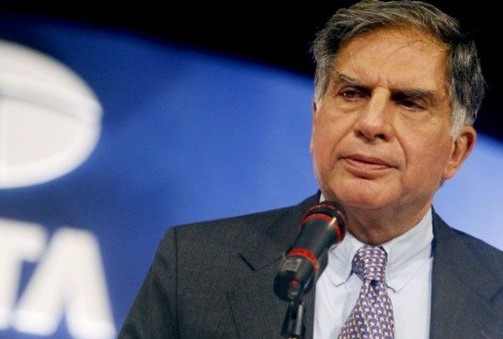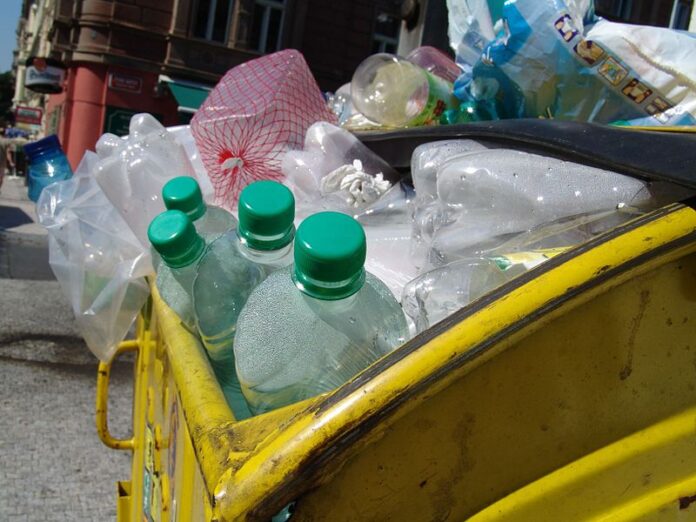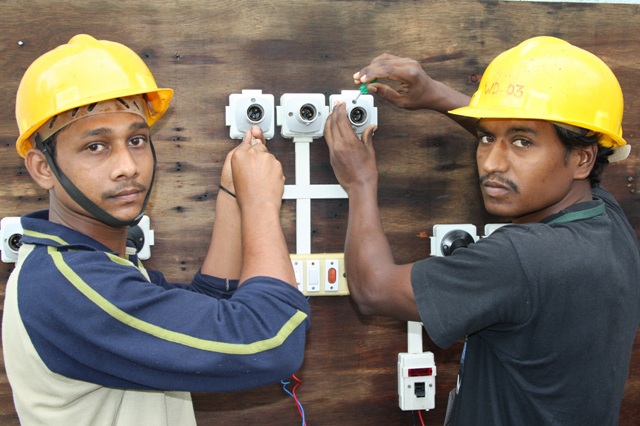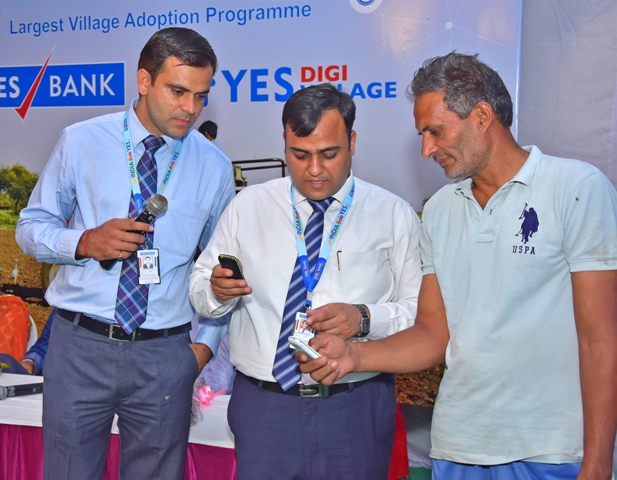CSR: Sportswear Made From Recycled PET
According to National Chemicals Laboratory, India produced about 1500 kilo-tonnes of PET in 2015-16. Recycling these bottles can generate over INR 3000 crores annually. Taking up on this opportunity, Paragon Apparels, the company producing sportswear for international brands such as Adidas and Reebok since 2001, has started to use these PET to recycle them and convert them into T-shirts.
Generally, sports garments are made of polyester, which ensures elasticity. Polyester is a manmade fibre which consumes huge quantities of water, chemicals and fossil fuels. It also leaves by-products which are toxic making it hazardous to the environment.
Replacing polyester with recycled PET is not only a productive solution of tacking the plastic waste in the country, but is also beneficial to the environment. The use of recycled PET reduces the carbon emissions by 54%, energy consumption by 50% and also reduces the water consumption.
Paragon Apparels use 8 PET bottles to convert into one sports wear t-shirt. Today, up to 50% of Paragon’s entire apparel line is made of recycled plastic PET bottles. The company produces over 4,000 pieces of such garments every day and sells more than 50,000 units every month.
However, while washing the clothes made of recycled plastic releases large amounts of plastic microfibres into water, according to the environmentalists. This remains undetected by filters as well as the sewage treating plants. It is estimated that half a million tonnes of plastic micro fibres, equivalent to more than 50 billion plastic bottles, shed during washing ends up in the ocean and ultimately enters the food chain. Thus, technically the clothes made by recycled plastic might do more harm to the health and the environment than good.
Thank you for reading the story until the very end. We appreciate the time you have given us. In addition, your thoughts and inputs will genuinely make a difference to us. Please do drop in a line and help us do better.
Regards,
The CSR Journal Team
Immunity Booster: Protect Yourself from Cold and Flu
Are people around you catching a cold? Winter colds and flus are an effort of nature to free the system from conditions that arise as a result of a violation of the laws of health. They are a house-clean, say health and wellness experts. Colds are needed to expel built-up waste. This house-clean will rarely need to happen if you follow these natural healing principles.
Principles for protecting yourself from cold and flu
1. Sun
Whenever possible, spend time in the sunshine, with as much contact with the skin as possible. This improves the circulation, oxygenates the body and enhances the digestion. Enjoy the health-dealing, life-giving power of the sun.
2. Ingest with care
Don’t take anything into the body that will harm it. This rules out all stimulants, saturated fats (which include margarine), all refined foods and animal products. These weaken the system and break down the fortifications that nature has set up to guard against disease and premature decay.
3. Early bedtime
Make sure you are in bed by 9:30 pm every night, earlier if possible. (This will ensure that your batteries are ‘recharged’ every night). Better to have an extra blanket on the bed and the window open a little, than a warm room with no fresh air while you sleep.
4. Movement every day
This is probably one of the most effective preventative measures. Only half an hour of brisk walking per day is all it takes. The key to the effectiveness of this is that the walk be brisk, causing the respiration to increase and the heart rate to rise. It also must become a daily habit, rain hail or snow. The best way to warm the human body is to warm it the way it was designed to be warmed: by activity.
5. Fuel
One portion of every meal should have raw food. Begin your meal with the raw food as it is alive with enzymes and digests quickly. If you find the raw food too cold, it can be warmed up with fresh garlic and cayenne pepper, which do not irritate, but only stimulate the circulation. Cooked, hot food is nice in the winter, but make sure it always has a raw accompaniment. A large breakfast, a big lunch, and a light or no evening meal is the eating program the human machinery thrives on.
6. Water
Drink two to three litres of water a day. This is not negotiable as this is what a human being of average height and weight loses a day. It must be replaced by water only. Dehydration is a big contributing factor in winter colds and flus. Early morning and between meals is best as it doesn’t interfere with digestion. Stop half an hour before a meal and resume 1.5-2 hours after a meal.
7. After shower
Use the cold to prevent colds. It is vital to finish every hot bath and shower with a 10-15 second cold rinse. Many have proven this an indispensable aid in preventing colds and flus.
Quick application of cold water is a marvelous tonic, giving tone to the muscles and nervous system, preventing a chilling and equalizing the circulation.
What to Do if You Catch a Cold
Here are several options to increase the body’s ability to ‘clean house’ quickly.
a) Drink a glass of water every ten minutes for an hour at the first sign of a cold. This will allow a quick house-clean and often prevent it going further.
b) Have a hot foot bath for 20 minutes. Put a teaspoon of mustard and half a teaspoon of cayenne pepper into the foot bath. Wrap a blanket around yourself, and drink two glasses of water while sitting there. Finish by pouring a jug of cold water over the feet.
c) Breathe deeply the freshest of air. Well-oxygenated air cleanses and purifies the bloodstream, and gives food to the lungs.
d)  Allow the sun to bathe the face and chest. Use safe sun: short bursts in the middle of the day, longer session when your shadow is as ‘long’ as you are. Sunshine touching the skin increases the circulation to those areas, which increases healing.
Allow the sun to bathe the face and chest. Use safe sun: short bursts in the middle of the day, longer session when your shadow is as ‘long’ as you are. Sunshine touching the skin increases the circulation to those areas, which increases healing.
e) On the first day, eat no food. Drink three litres of water through the day, as well as herb teas, such as peppermint. Have fresh fruit and vegetable juices every couple of hours if desired. On the second day, eat RAW food only. Sprinkle the salad with a dressing of olive oil, lemon juice crushed garlic and cayenne pepper. Avoid grains, as they are mucus-forming when you have a cold. Slowly reintroduce grains and legumes as the cold subsides.
f) Spend a small portion of the day resting; early nights are vital. The body is designed to restore and health while it sleeps.
g) A brisk walk warms the body and increases its healing powers by increasing the circulation and the burning off and expelling of waste.
This wellness article is part of a series on natural healing.
Over 5 lakh candidates placed under Pradhan Mantri Kaushal Vikas Yojana (PMKVY)
Owing to the successful implementation of Pradhan Mantri Kaushal Vikas Yojana (PMKVY 2016-20), the Ministry of Skill Development & Entrepreneurship (MSDE) continues to strive towards fulfilling the vision of a “Skilled India”.
The scheme has witnessed an exponential increase in generating employment opportunities with 5.25 lakh placements. During the last financial year 2017-18, there has been a significant increase in placements due to infrastructure development, expanding training partner network and stringent monitoring processes; making the scheme more effective and constructive with an over-riding focus on quality.
The placements under PMKVY (2016-2020) are categorized into wage and self-employment. Nearly 78% of the candidates have been placed in wage employment while 22% in self-employment/entrepreneurship. The top 10 performing sectors with respect to placements are Apparel, Electronics and Hardware, Retail, Beauty and Wellness, Telecom, Logistics, Agriculture, IT-ITeS, Tourism and Hospitality and Construction encapsulating 85% of the total placements.
Addressing gender inequality in the workforce, the scheme has shown significant gains, with women constituting 55% of the total placements. Meeting the industry demands, the placements have been skewed towards service sector with major placements in apparel, tailoring, computing and peripherals, retail sales, customer care and beauty and wellness job roles.
Rajesh Agrawal, Joint Secretary & CVO, Ministry of Skill Development and Entrepreneurship (MSDE) said, “PMKVY (2016-2020) aims to provide quality training to build skilled and job-ready workforce catering to the evolving demands of the industry. The placement progress brings to fruition the Government’s vision of providing meaningful employment and livelihood opportunities for all. The placement trend also shows high demand in service sector. In a vast country like India, where unorganised sector is predominant, entrepreneurship can be a key enabler for employment generation.”
Manish Kumar, MD & CEO, National Skill Development Corporation commented, “We are encouraging quality training in industry-relevant job roles for better placement outcomes. We are also enhancing self-employment capabilities of skilled youths by integrating digital literacy, soft skills and entrepreneurship modules with PMKVY.”
Placement drives are conducted providing employers and candidates with a common platform to interact and fulfill the placement directive of PMKVY 2016-2020. The scheme has associated with more than 7,000 employers across India through approximately 800 Rozgar Melas in the last 18 months.
The scheme has facilitated connect with leading employers, such as Myntra, Pizza Hut, PVR Cinemas, Bata India, G4S Secure Solutions, Lemon Tree Hotels and Honda Motorcycle & Scooter Pvt. Ltd. to name a few.
YES BANK Launches ‘YES Digi Villages’, India’s Largest Bank-led Village Adoption Programme
The 1st YES DIGI Village was launched in Abhimayupur (erstwhile Amin) in Haryana, empowering over 100 farmers through digital and financial literacy sessions and introduction of Sim Se Pay, India’s first mobile banking solution for feature phone users and villagers with no internet connectivity.
‘YES Digi Village’ programme is envisioned to empower village communities and 30,000 farmers with knowledge about Good Agricultural Practices (GAP) accelerated by creating a robust digital and financial literacy programme, making it the largest bank-led village adoption programme in India. Villages across India will be identified for the YES DIGI Village programme on the basis of available cultivable land, irrigation facilities, cropping pattern, credit culture among other key productivity criteria.
Sumit Gupta, Group President and Group Head: Rural Banking and Small Medium Enterprises Banking, YES BANK said, “YES BANK is committed to furthering the Government of India’s vision to ‘Double Farmers’ Income by 2022’ through ’YES Digi Village’ programme. In continuation with YES BANK’s efforts towards developing a digital ecosystem and furthering financial inclusion, in rural as well as urban areas, we plan to leverage our extensive branch network and harness the potential of our agritech partnerships through YES SCALE Agritech accelerator, thereby also maximize the number of lives impacted.”
‘YES DIGI Village’ is targeted towards enabling farmers with knowledge and skills to improve existing processes and explore newer revenue generation opportunities with the help of Agritech and Fintech solutions. To this effect, YES BANK also plans to integrate its existing capacity building programme for farmers in over 350 villages across states including Uttarakhand, Haryana, Punjab, Rajasthan, Gujarat, Madhya Pradesh and Maharashtra.
Literacy Initiatives:
- YES BANK will further financial inclusion by providing financial literacy as well as promoting utilization of digital banking tools, which will be imparted through workshops, specially designed for village communities.
- Training focus areas will include technologies like Mobile Banking, Internet Banking/M Wallet, Sim se Pay, ATM, online Savings, loans, account opening etc. as a part of digital and financial literacy. Additionally, GAP training imparted to farming communities would include sessions about crop rotation, drip/sprinkler irrigation, integrated nutrient management etc.
Technology Support:
- The Bank is partnering with technology companies to assess customers’ alternate agronomic data related to crop risk management using satellite images and advanced machine learning. The solution will also aid in credit decisioning by providing alternate data points related to historic cropping pattern.
- The Bank has also identified startups to explore development of a Land Record Management solution to assist in credit decision by providing detailed report on land revenue documents and assisting in prevention of frauds. This would eliminate need for physical field visit during credit appraisal.
Easing Banking Services:
-
- Additionally, solutions are already being customized for village communities and implemented to enhance the overall digital banking experience with assisted digital services like loan application, handheld devices for E-kyc/ E-doc/ E-sign making it a completely paperless experience for rural customers, leveraging India Stack and mobility platforms for instant, paperless, error free customer on-boarding.
Changing Corporate Outlook on CSR
In 2014, India became the first country in the world to mandate companies to spend a fraction of their revenue on Corporate Social Responsibility (CSR). However, long before the Companies Act 2013, cultural beliefs in daan and good karma, have always been a deep-rooted part of India’s corporate culture.
Business houses such as the Tata’s and the Godrej’s have been bastions of social stewardship, undertaking a number of social welfare initiatives through years. While corporates have always played their part and have extended timely support, responsibility of social transformation has largely been borne by the Government and few non-profit organizations.
The CSR mandate by the Government of India is aimed at forming a collaboration between the corporate world, NGOs and Governments to work together for creating a large scale positive impact and mainstreaming social responsibility in the DNA of Indian organizations. The enactment of CSR rules has witnessed a tremendous impact on the evolving outlook and definition of CSR in India.
It is worth revisiting the corporate journey of organizations’ past to analyze how CSR has evolved over the decades.
Past
Pet Projects:
Earlier, CSR projects were driven by senior executives of companies based on their inclination towards causes that intrigued them. Selection of such projects, typically known as pet projects, were highly subjective in nature without scientific backing or empirical assessment. These projects were also unsustainable, considering they could easily disintegrate when executives left their organizations or changed their areas of interest.
Philanthropy:
Philanthropic contributions marked the next step in the evolution of CSR. With an aim to bring about social change in a more sustained manner, corporates donated large sums of money to charitable foundations. While this method helped channelize CSR funds towards proven long term programs, it failed to harness corporate efficiencies in effecting large scale impact.
Present
Currently, CSR spend is driven primarily by the CSR law. The philosophy of comply-or-explain mandates companies falling under certain criteria to spend a percentage of profits, on CSR activities, failing which they are required to provide an explanation for the unspent amount. On the other hand, the mandatory spend has driven corporates to treat CSR more strategically.
Partnerships:
In the current scheme of things, corporates are partnering with NGOs and Government entities for implementation of their CSR activities. They are moving towards a more collaborative model where businesses are focusing on scalability through partnerships. Corporates are also allocating more funds to CSR than the prescribed law, showcasing their conscious approach to the prevalent social issues.
However, these expenditures, in some cases, are made in the form of financial contributions without focusing on impact, underscoring the need for a more comprehensive approach for the future of CSR.
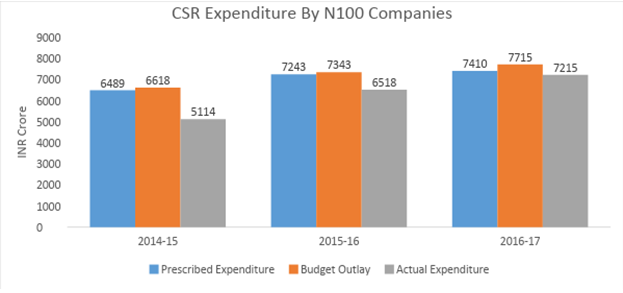 Source: KPMG CSR Survey Report
Source: KPMG CSR Survey Report
N100: List of companies identified by KPMG for study
Future
Shared Value Approach:
As businesses continue to grow in size and number, with revenues of some companies larger than the nations, their potential environmental and societal impact increases accordingly. In order to ensure that businesses have a net positive socio-economic impact, a fundamental change needs to be brought about in the way corporates look at their responsibility towards society.
When corporates treat CSR simply as an expenditure to be made for compliance, it becomes more of a liability than a step towards social transformation. There is a need to create a business case for CSR in order for it to be embedded into a corporate’s business strategy.
In order to build such a business case and get all stakeholders to focus on long term impact, there is a need to go beyond compliance and look at a business model of shared value. This would ensure that businesses don’t merely mobilize CSR budgets, but also grow as a result of the same.
A shared value approach treats CSR not only as a means to benefit the society, but also as a strategic tool to tackle long-term socio-environmental challenges faced by corporates. CSR is no longer viewed as an expenditure, but rather as an investment towards sustainable societies and businesses.
Corporates bring with them decades of expertise in executing large scale projects and driving efficiencies. These skills are critical in achieving nationwide positive impact. Augmented by on-ground expertise of the development sector, and the enabling environment created by the Government, corporates can leverage their expertise and resources to help create a sustainable future by following a shared value approach to CSR.
 Namita Vikas is Group President & Global Head, Climate Strategy & Responsible Banking at YES BANK. She was recently voted amongst Asia’s 26 Top Sustainability Superwomen. As the Chief Sustainability Officer of the Bank, she spearheads Sustainable Development and CSR, thus driving sustainability principles within its core operations and its value chain towards creating stakeholder value. Namita has an Advanced Management Degree in CSR and Leadership from the Swenska Institute, Sweden.
Namita Vikas is Group President & Global Head, Climate Strategy & Responsible Banking at YES BANK. She was recently voted amongst Asia’s 26 Top Sustainability Superwomen. As the Chief Sustainability Officer of the Bank, she spearheads Sustainable Development and CSR, thus driving sustainability principles within its core operations and its value chain towards creating stakeholder value. Namita has an Advanced Management Degree in CSR and Leadership from the Swenska Institute, Sweden.
Views of the author are personal and do not necessarily represent the website’s views.
Thank you for reading the column until the very end. We appreciate the time you have given us. In addition, your thoughts and inputs will genuinely make a difference to us. Please do drop in a line and help us do better.
Regards,
The CSR Journal Team
CSR: Air Pollution Statistics of India
India is facing a major pollution crisis. 14 of the 20 most polluted cities in the world are in India. This has caused it to hold the burden of the highest pollution related mortality rate and disease. According to a report by the World Health Organisation, there were about 60,987 deaths of children under the age of five years old in India, that was caused due to exposure to PM2.5 in 2016. Of them, 32,889 were girls and 28,097 were boys.
India has the highest number of deaths in the age bracket of less than five years old. In the age bracket of five to 14, India saw the deaths of 4,360 children in 2016. More than 2 million premature deaths are estimated to occur due to air pollution. This accounts for 25% of the global deaths.
According to WHO, more than 90 per cent of children in the world which accounts to about 1.8 billion children, breathe toxic air every day. Out of this, about 6 lakh children in 2016 are estimated to have died from acute lower respiratory infections caused by polluted air.
Children are susceptible to hazardous effects of pollution both during pregnancy and after being born. Pregnant women exposed to air pollution are more likely to give birth prematurely. Babies are vulnerable to the effects of pollution as they breathe more rapidly than adults, absorbing more pollutants. For children, as their bodies and brains are still developing, it also affects them more.
The babies of the pregnant women living in highly polluted areas often suffer from issues such as low birth weight. Air pollution also impacts the neurodevelopment of the child, their cognitive abilities and motor development in the longer run. It can also trigger asthma and childhood cancer. Later on in adult life, these children are also susceptible to develop chronic diseases such as cardio vascular disease.
In order to combat pollution, WHO is urging the countries to adopt urgent measures. It has suggested switching to more energy efficient lifestyle and urban planning in order to reduce emissions. Besides, it has recommended that children should be especially kept away from pollution. Hence, the schools and playgrounds should be kept away from roads, factories and power plants.
Thank you for reading the story until the very end. We appreciate the time you have given us. In addition, your thoughts and inputs will genuinely make a difference to us. Please do drop in a line and help us do better.
Regards,
The CSR Journal Team
CSR: India To Ban Crypto-Currencies
India is going through a digital revolution. Where on one hand the government is encouraging the use of digital in majority of sectors, it is placing a ban on crypto-currencies which is creating a havoc in the industry.
According to the official release by the Press Information Bureau (PIB) of the government of India, the country’s financial stability and development council (FSDC) has deliberated banning the use of private crypto-currencies in India, in a meeting on Oct. 30. The FSDC is a high level committee of officials, headed by Finance Minister Arun Jaitley, to study risks to the Indian Financial system.
The crypto-currency market is suffering in India since the Reserve Bank of India’s (RBI) regulation of barring the Indian banks from having any business relationship with exchange and traders. The trading volumes have dropped down significantly since the move. The exchanges have only existed in form of peer to peer and crypto to crypto trade. A Blanket ban will stop even that which would cause all exchanges with only two options – one would be to shut down and other would be to move to a foreign location where the crypto trading is legal. The latter option being not too feasible for smaller exchanges, will cause a loss of business.
Apart from the damage to the economy, the already technologically poor India will also face a damage in terms of block chain related technological development. The government of India is keen on adapting the use of block chain technology in healthcare, banking, real estate, education and farming. However, according to the experts, this approach is a contradiction and dos not make sense.
The block chain technology is closely bound to crypto-currency. Removing crypto-currency from the block chain will make the database extremely slow, and hinder with the operations. This will shy away the institutions in the country from using this outstanding technology.
Thank you for reading the story until the very end. We appreciate the time you have given us. In addition, your thoughts and inputs will genuinely make a difference to us. Please do drop in a line and help us do better.
Regards,
The CSR Journal Team

